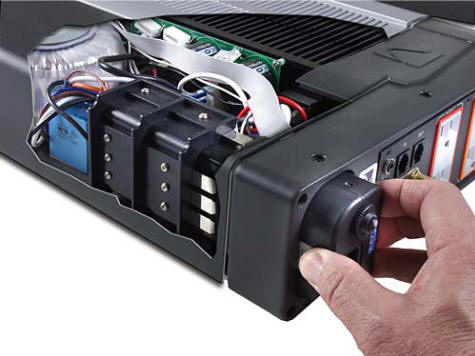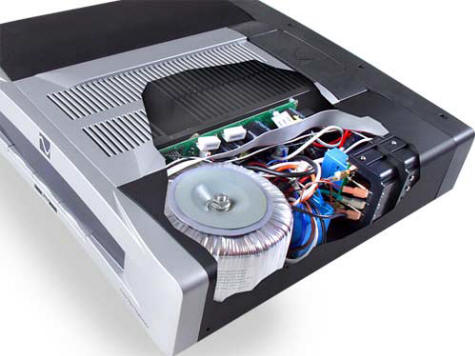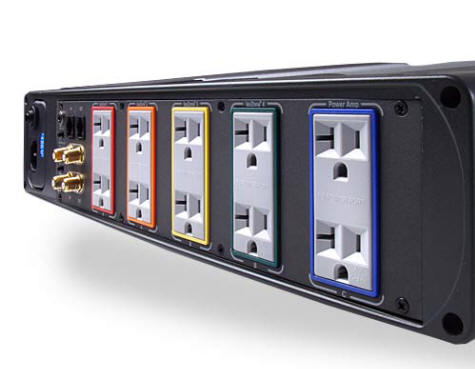
You are reading the older HTML site
Positive Feedback ISSUE
november/december 2007
ps audio
Premier Power Plant
as reviewed by Mike Wechsberg

|
MIKE WECHSBERG'S SYSTEM
LOUDSPEAKERS
ELECTRONICS
SOURCES
CABLES
|
Can a single component revive a decent but geriatric audio system in need of some tender loving care? I'm a long-time audiophile who enjoys many types of music as well as the thrill of owning and using good quality equipment. But, I'm not the sort who likes to tinker constantly with the gear. I've built my system by carefully selecting synergistic components through listening tests and research. I also shop for good value since I have to split my meager funds between multiple hobbies and interests. Once I pick something I stick with it so, I hadn't changed anything significant in my system for more than two years. Lately, I've noticed some of the thrill is gone, especially when I compare my home experience to what I hear at some of the local audio salons. I knew the answer to my question above was "yes, certainly my system can be revived", but deciding which component to change, and finding the most sonic impact for the least money was the challenge before me. Off I went to the recent Rocky Mountain Audio Fest south of Denver to find answers.
The Audio Fest was drowning in amps, preamps, CD players, turntables and speakers. All manner of accessories were also showcased. PS Audio, a company well known to most audiophiles, had a large exhibit dominated by their power conditioning and power management equipment rather than by amplifiers and audio source components. Here I heard about the new Power Plant Premier power regenerator and was impressed by its ability to clean up the ac power coming from the wall outlet and by the corresponding improvement to the sound of their demonstration system. Before considering purchase of a power conditioner for my system, however, I decided to do more research at the show.
I dropped by the Power Modules, Inc. room where David Belles was holding court. David has been in the audio business for many years and the sound quality of his amplifiers and preamps has always impressed me and many other audiophiles. He is an extraordinary engineer and really knows how to make amplifiers sing. The latest amplifiers from his company are exceptionally good but I rarely see them reviewed. At the show he was demonstrating his new LA-01 Preamplifier and MB-200 monoblock power amplifiers with the new Usher Be-718 Tiny Dancer speaker and the sounds coming forth were absolutely beautiful—better than Usher was able to produce in their own demonstration room downstairs. Of course much of the art in producing a good amplifier is devoted to the power supply section. Surely David would know if power conditioning made a difference to the sound; yet his company does not make power conditioning equipment so he would have no prejudice one way or the other. David was emphatic that power conditioning is needed because the amplifier designer can only do so much inside the amp, plus the quality of power around the country is so variable if would be wasteful to design for the worst case. This advice convinced me to listen more closely to the PS Audio power conditioners.
How the Premier Power Plant Works
Before beginning this section I should mention that I'm an electrical engineer by profession, but I've never been an electronics designer and I've been on the management side of the engineering business for many years. So, I know enough about circuits to be dangerous but, like most audiophiles, I'm no expert. However, I do understand a few things more than the average audio consumer that lets me separate some of the mumbo jumbo from real facts. I'm also a believer that the truth is in the listening.

The feature that drew me to the PS Audio Premier is that it is a power regenerator, not just a conditioner. The PS Audio web site has a good article that contrasts the many types of power conditioners with their regenerator. My simple explanation is that the Premier takes in the "dirty" and variable AC power from the wall socket, converts it to a DC voltage and then regenerates a "perfect" new AC sine wave signal at 120 volts which is what all good US audio equipment hopes and prays for. In this way the Premier takes care of voltage drops and surges that vary with the load as well as sine wave distortion that we all live with courtesy of our power companies. The Premier also has a "multiwave" feature that reduces ripple on the power line (see web site for more details). This type of power regeneration was what I have always looked for in power conditioner literature and never found until the PS Audio Premier came along. It is a unique product for audio. A similar approach is used in power conditioning equipment for US military hardware, where power conditioners often cost $10,000 to $20,000 and are built like battleships (because some times they are used on battleships). It's the only way to be sure that sensitive military equipment will continue to operate in stressing war time conditions where power interrupts, surges and fluctuations are likely to occur. The Premier gives you much of the same capability for $2195. You might not think you need this type of bulletproof performance, but reserve judgment until you read about my listening tests below.

The Premier features 10 high quality AC outlets organized into five isolated zones so that digital equipment plugged into one outlet does not corrupt analog components plugged into other outlets (and vice versa). It even has a remote control that turns the unit on and off and regulates the display. The display is a useful and informative feature of the Premier. It can show you the incoming voltage and total harmonic distortion as well as the output voltage and distortion. Over my week or so of listening I noticed the input voltage vary from 119 to 122 volts and the distortion range from 1.8% to 3.0%. The Premier output was a rock solid 120V at 0.3% distortion or less. The Premier has a power sequencer feature so that power surges that occur when you activate your audio system won't trip the circuit breaker. It also has field replaceable surge and spike protectors and state of the art filtering technology using Nano Crystalline materials. The latter is a new high permeability magnetic material engineered using nanotechnology, which is all the rage in military research and development circles. Nanotechnology attempts to manipulate materials at the molecular level to generate new properties. The benefits of this new research are just beginning to be felt in consumer products and they will have a large impact in the future. In the Premier the use of Nano Crystalline magnetic material allows PS Audio to build effective filter coils with less copper, therefore reducing resistance and inductance that might rob music of some of its dynamics. Very importantly, the Premier can handle up to 1500 W continuous which should make it possible to plug in all your audio components except the biggest Class A power amplifiers. It can get quite warm depending on the power load so no components should be stacked on top and adequate ventilation should be provided. The Premier comes with an 8 foot heavy gauge power cord, but PS Audio encourages substitution of an aftermarket power cord (I used the stock power cord). They also recommend use of spikes and vibration damping solutions to further improve performance. Surge protection for cable TV/satellite and for telephone lines is also provided. The Premier is solidly built and handsomely designed to complement any type of audio system from the most modest to the most expensive. The light blue display, which can be dimmed or turned off via the remote, gives it an elegant aura.
Listening Tests
Rather than plug all components into the Premier at once and describe what I heard, I decided to engage just one component at a time in order to gain more insight into the effect of regenerated power on my audio system. I started with my reference components plugged into my Monster Cable power strip (the power amp is plugged into a separate Monster surge suppressor on a different outlet). I selected several LPs and CDs to use as a source material and listened to them all in this baseline configuration. Speakers were my first generation Wilson Cubs. Interconnects were a combination of Nordost Blue Heaven and MIT Terminator series.

The first component that I powered via the Premier was my VPI Scout turntable. I'm using a Sumiko Blue Point Special cartridge from a few years ago because my medium output Grado Sonata had been recently damaged. My expectations for hearing any difference with just the turntable plugged into the Premier were low, however, I was startled by the difference I heard. The music seemed louder with more pace and was overall more involving. The horns in Steamroller on the new RTI pressing of James Taylor's Sweet Baby James seemed better organized, and on Country Road the bass was definitely more solid and the piano easier to follow. On Mary Gautier's Between Daylight and Dark the bass line on Can't Find the Way did not go any lower but seemed firmer, stronger and less flabby and this helped draw me deeper into the music. The Premier had the most dramatic effect on the lows on all the cuts I played, making bass notes more distinct, but not necessarily any lower. This may be the Premier's multiwave feature working. The effect is probably similar to upgrading the motor on the VPI from my stock unit to the more impressive 300 RPM version. The enhanced lows allowed other portions of the spectrum to shine and making the music more enjoyable. A great first step!
The next item receiving the Premier treatment was my Music Hall Maverick CD player. I heard an astounding effect on Eva Cassidy's Live at Blues Alley recording. On Fields of Gold I was barely able to scribble notes because the singing sounded so beautiful, but I vividly remember new levels of detail and clarity in Ms. Cassidy's voice and her accompanying band mates each became an individual player floating in the intimate Blues Alley space. On this cut and on Cheek to Cheek I heard all sorts of details that weren't evident before on the piano, guitar and drum kit. Even my cat, who usually prefers classical LPs, just sat in front of me and listened to this beautiful CD music unfold. Switching to the XRCD version of The Planets, played by the Los Angeles Philharmonic and conducted by Zubin Mehta, Jupiter, the Bringer of Jollity never sounded jollier or bolder. The strings became more like an ensemble and on loud passages the music exploded out of a much quieter background. New details abounded in the highs and bass transients were much improved.
However, it was when I re-listened to these two CD recordings with my Audible Illusions Modulus III preamp plugged into the Premier as well that I began hearing things from my system that I'd never heard before. Backgrounds were much quieter and Eva Cassidy's voice emerged from a blacker space and stood out in sharp contrast from the accompanying instruments and venue. Previously masked breath tones and musical details were suddenly there as if in the room. The soundstage on Jupiter became much wider and the instruments that were formerly crowded together were now pulled apart and heard as separate sources. Percussion instruments had more color and the entire tonal balance seemed to tip up as more and more details emerged in the highest parts of the spectrum. Dynamic contrasts in the music became much more dramatic which made me very happy as this is one of the sonic characteristics I most covet in my listening.
Next I switched to LPs again, this time with the preamp plugged into the Premier. Starting with the Classic Records reissue of the RCA Living Stereo recording of Festival featuring Reiner and the Chicago Symphony I heard a noticeable improvement to the air around each instrument. Bass was tighter, backgrounds seemed quieter and dynamics were much improved. On the Tchaikovsky Marche Slave, the soundstage was obviously wider and I was able to enjoy all sorts of new details I never heard before at the back of the orchestra. Going back to James Taylor, I especially enjoyed the horns on Sunny Skies and this entire cut seemed to swing more than it had before I introduced the Premier into my system. On this recording and on the Mary Gautier the quieter backgrounds were obvious and it was much easier to follow the lyrics and get into the music. The fine details of Mary Gautier's voice became most enchanting and I now understood why she has been gaining so much attention for her beautiful voice. The Premier had the comparable effect of upgrading my phono cartridge by several hundred dollars.
Finally, I plugged my Krell KAV-250 amplifier into the Premier together with all the other components. The sound on both LPs and CDs took another leap forward. On the James Taylor LP another level of haze was removed from the mix and the recording seemed less like a recording and more like a personal concert. The Premier had its most dramatic effect on the depth of the soundstage when the Krell was engaged. For example, on Steamroller the horns were further back in the mix and more distinct from James' guitar. Mary Gautier's voice became even more mesmerizing than before and all the instruments seemed in perfect balance to communicate the message of each song. Then on the Reiner Festival the sound stage took on greater width and the dynamics were startlingly realistic. My system was able to convey some of the magic of the RCA Living Stereo recordings that I was missing before.
On my two CD references I was now hearing the music with less haze, more depth and a greater sense of the recording space than ever before. The music was more infectious and it was disappointing to come to the end of the disk. The Premier's effect on the Krell amp was not subtle and very real.
Final Words
The revelation of my experience with the Premier was that I had been suffering with poor AC power quality for a long time and I was missing a significant amount of the sonics that I paid for when I bought my components. For me the addition of the PS Audio Power Plant Premier into my system was extremely satisfying and worth all of its $2195 cost. It made a substantial improvement to everything I played much like buying a better set of speakers or a better power amp. I noticed in subsequent listening that I was able to play music at a lower level than before because I was no longer straining to hear details and the dynamic contrasts were so much better. I've become a true believer in the principle of power regeneration. Whether you will experience as dramatic a change in sound in your system depends on many factors. The power coming into your home may be better than mine, and the quality of the power supplies in each of your components may be different and benefit to a greater or lesser degree from the clean up that the Premier performs. Also, I have not compared the Premier to other types of power conditioners that might have some of the same impact. However, I can confidently state that the Premier is a high quality audio component, backed up with sound engineering and construction, and worthy of your attention and trial. Don't cheat yourself like I have by ignoring the AC power going to your components. Strongly recommended. Mike Wechsberg
Premier Power Plant
Retail: $2195
PS Audio
web address:
www.psaudio.com
